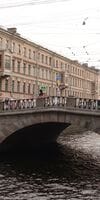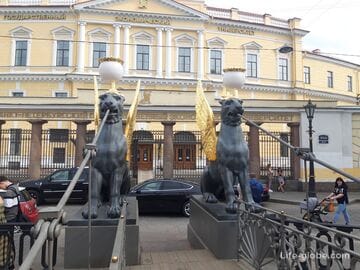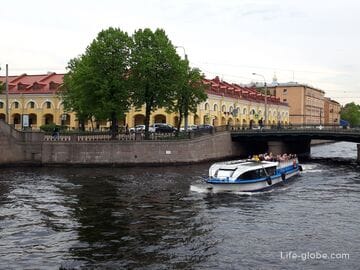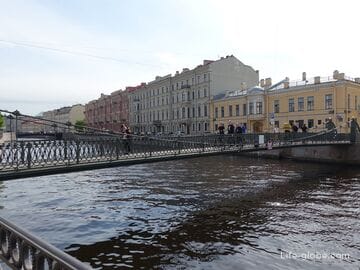The Stone Bridge is one of the historical bridges in the center of St. Petersburg.
Today, the Stone Bridge is an architectural monument of the 18th century, as well as one of the few such oldest buildings in the city that have not undergone radical reconstruction.
Due to this, there is a preserved characteristic technological feature of bridge construction of the 18th century in the bridge design - it is a rather steep bend of the bridge arch.
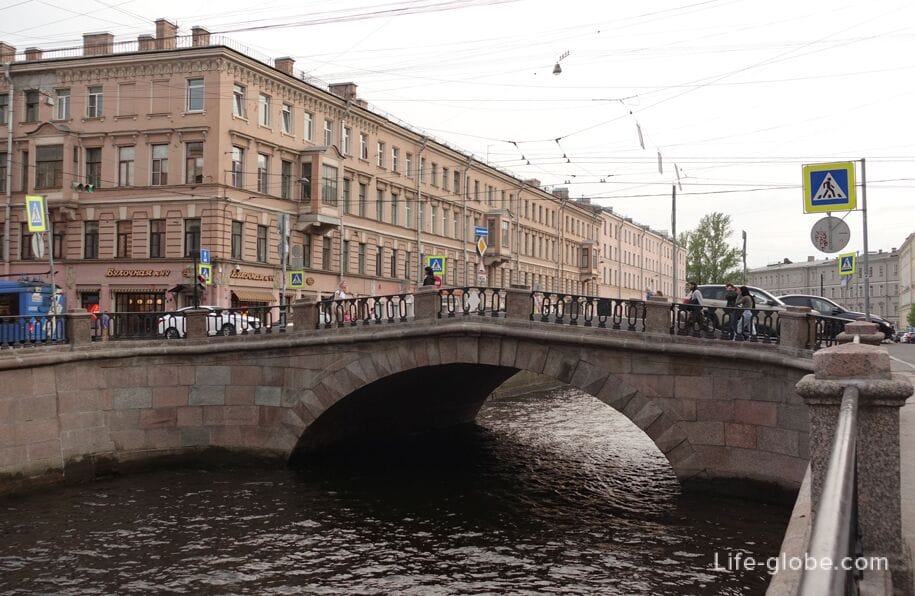
A stone bridge spans the Griboyedov Canal along the axis of Gorokhovaya Street, and connects the Kazan and Spassky Islands. The bridge marks the border between the Admiralty and the Central districts of St. Petersburg.
The bridge has a total length of 19.7 meters and a width of 15.08 meters. Due to its size, the bridge looks almost square in the panorama of the city.

The stone bridge is a single-span arched structure, the span of which is a vault of parabolic outline, lined with granite from the facades.
The abutments of the bridge are made of rubble slab.
The lining of the bridge consists of smooth granite blocks alternating with blocks in the form of tetrahedral pyramids - the so-called "diamond rust". With this treatment, the protruding edges, being polished, sparkle brightly in the sun, resembling cut diamonds.
The drawing of the bridge railing repeats the pattern of the railings of the embankment of the Griboyedov Canal - cast-iron balusters with massive granite bollards and a metal handrail.
The stone bridge is a roadway and pedestrian.
Pedestrian sidewalks are located on both sides of the bridge.
The pavement on the bridge is asphalt concrete. The sidewalk is separated from the roadway by a granite parapet fence.

The bridge offers views of the Griboyedov Canal and the embankments of the canal with historical buildings, as well as the pedestrian Flour Bridge located upstream of the Griboyedov Canal from the Stone Bridge. Downstream is the Demidov Bridge.
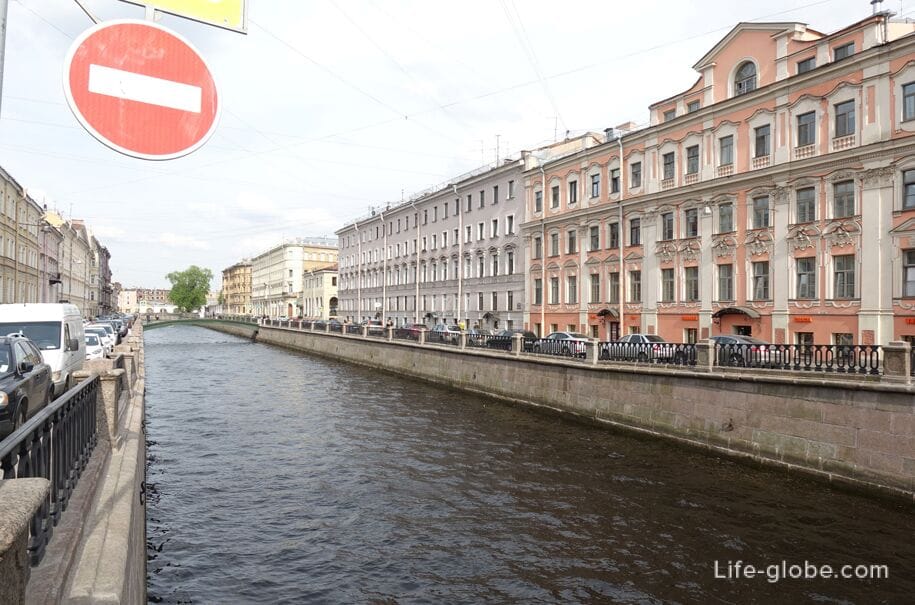
Near the Stone Bridge, at the address: Embankment of the Griboyedov Canal 40 and Gorokhovaya Street 26, there is a corner historical building - the Grabbe house or the apartment house of A. Kotomin, named after the names of the former owners.
The house was built in the 1750s, and after it was built over and underwent reconstruction.
The building is made in the Baroque style and is an example of a mid-18th century residential building in St. Petersburg.
The main facade of the building faces the Griboyedov Canal and is decorated with Corinthian pilasters, the windows are framed with Baroque architraves; the plane of the walls is filled with decorative details.
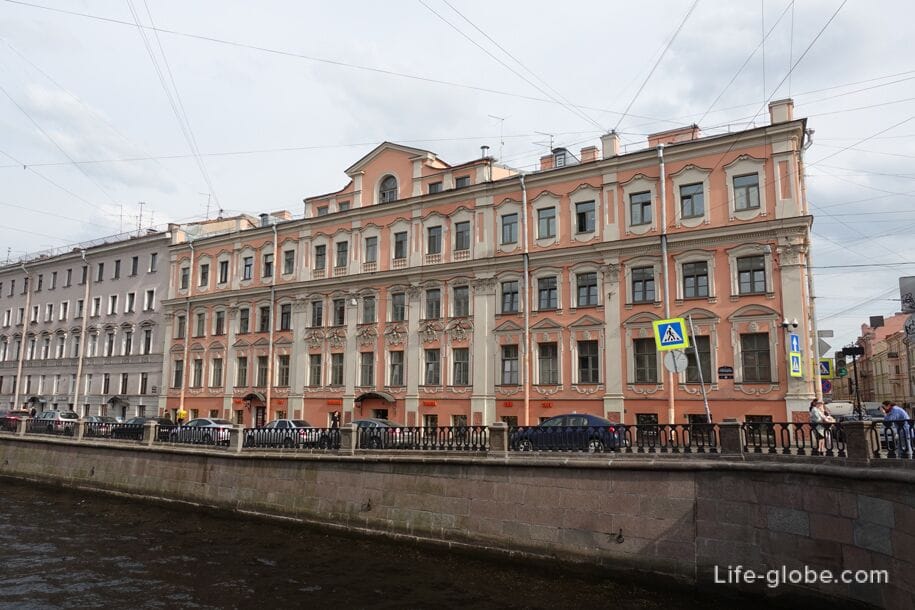
History of the Stone Bridge
Since 1752, there has been a wooden pile bridge in this place, then called the Middle Bridge, after the name of the street (the current Gorokhovaya Street).
A permanent bridge made of stone instead of wooden was built in 1767-1776 by engineer V. Nazimov.
Initially, the bridge had four semicircular staircases to the water, which were eliminated at the turn of the 19th and 20th centuries. At the same time, the steepness of the entrances to the bridge was somewhat reduced.
Despite the fact that there are several stone bridges in St. Petersburg to this day, only this bridge over the Griboyedov Canal became known as the Stone Bridge. Perhaps it was this structure that became the first stone bridge in the city, where only wooden bridges were built up to that moment. Or maybe the bridge got its eloquent name because the peculiar beauty of the masonry is especially convincingly revealed in its appearance.
In 1988, an elevated granite parapet was installed on the bridge, separating the sidewalk from the roadway.
Interesting things about the Stone Bridge
In 1880, terrorists from the Narodnaya Volya society, preparing another attempt on the life of Emperor Alexander II, laid 7 pounds of dynamite under the Stone Bridge. But the attempt did not take place at that time: the people's volunteers were not sure of the power of the explosives laid and canceled the action. The bomb was found at the bottom of the Catherine Canal (now the Griboyedov Canal) in the spring of 1881, after the assassination of the tsar, during the investigation of the "case of sixteen".
At the beginning of the 20th century, the steep ascent to the Stone Bridge proved to be a difficult obstacle for the first St. Petersburg buses. According to eyewitnesses, during rush hour, the conductors had to drop off passengers in front of the bridge, they crossed the crossing on foot, and the bus was traveling light. On the other side of the canal, passengers resumed their seats, and the bus continued along Gorokhovaya Street, rolling downhill.
After the war and the siege of Leningrad, the metal bridge stand with the name of the bridge was preserved only on the Stone Bridge. In 1949, it served as a model for the manufacture of similar racks with the names of other bridges in the city.
Practical information
Coordinates of the Stone Bridge: 59°55'49.0"N 30°19'08.0"E (59.930278, 30.318889).
Nearest metro stations: "Nevsky Prospekt", "Gostiny Dvor", "Admiralteyskaya", "Sadovaya", "Spasskaya" and "Sennaya Ploshchad".
All accommodation facilities in St. Petersburg, including in the city center and more remotely from it, can be viewed and booked here




